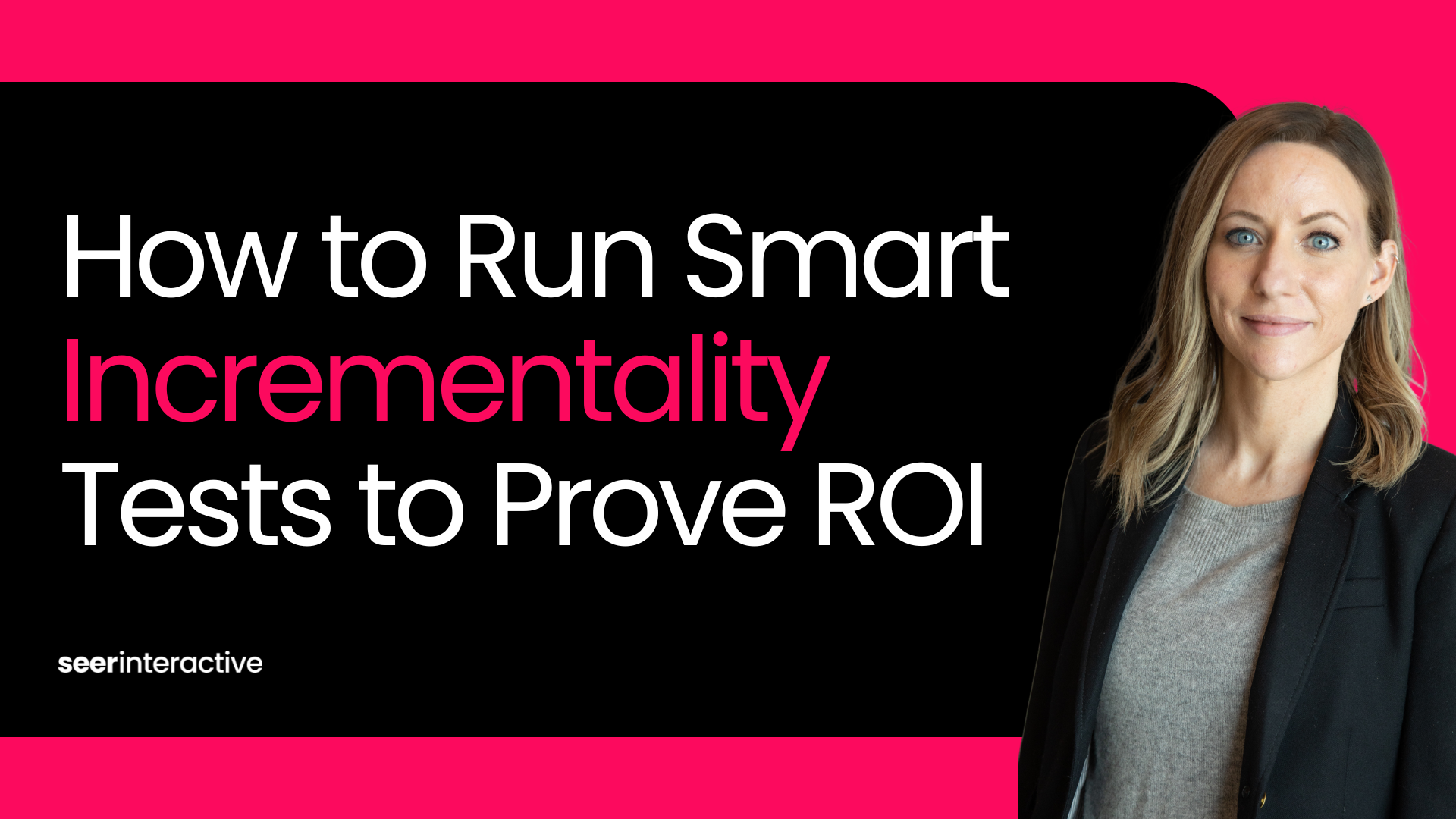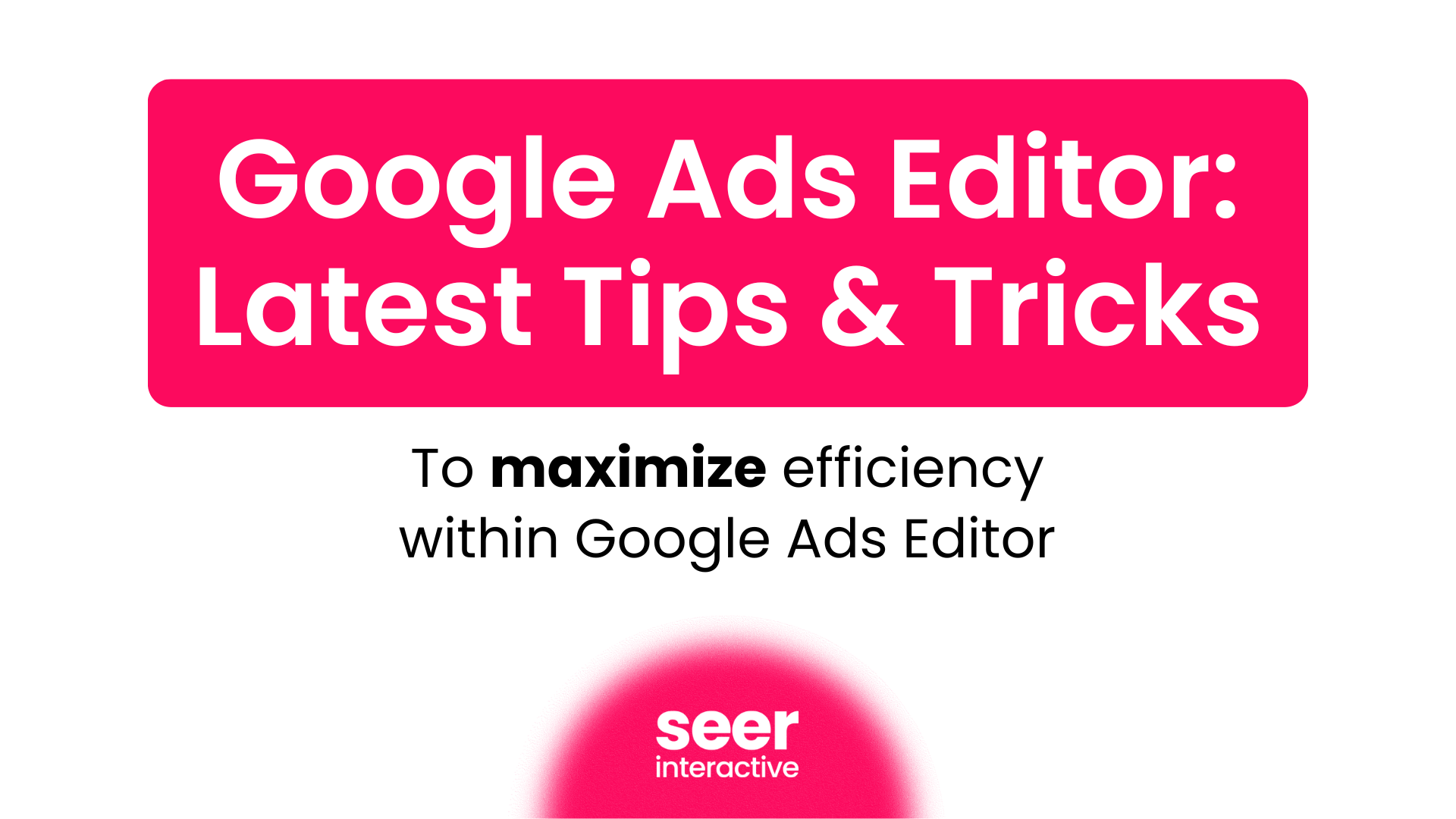Our Guiding Light
If you’re working in e-commerce marketing, you know just how important it is to have proper objectives, processes, and measurements before diving into your paid social strategy. How are you supposed to measure the return on investment and value-added without it?
Here at Seer, our Paid Social division has broken out a step-by-step e-commerce measurement strategy that will be sure to get your client excited. Before jumping in, let’s outline the conversion funnel and corresponding campaign goals that we’ll be referencing throughout this guide:
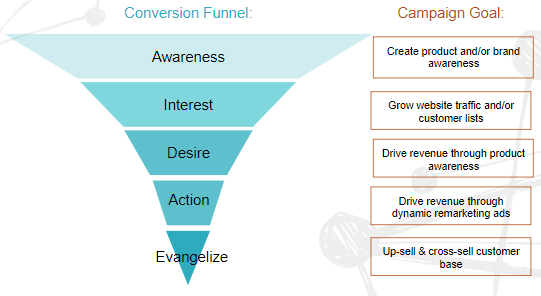
We’ll walk you through each stage in the conversion funnel, laying out our KPI guide that will help to inform your measurement strategy.
It’s important to preface that the process of developing KPIs at Seer is an interactive process between the client and the account team. What may be our guiding light at Seer in regards to an e-commerce measurement strategy, may just be a guide for you when it comes to your client’s needs.
Communicate with your client about their specific goals and cater the KPI strategy to have a clear and defined picture of what success looks like.
First, let’s start by asking these strategic questions:
- What is the desired goal you wish to accomplish?
- How will I accomplish this goal?
- How will I know when I’ve accomplished this goal?
Now, let’s get started.
Measuring Brand Awareness
Goal
Our first stop in our e-commerce measurement strategy is awareness. Your client has come to you with a burning desire to increase awareness of a product and/or brand. At Seer, this is when we’ll look to introduce new audiences to branded content.
More specifically, the type of ad format we recommend using is a video ad. Video ads are a great way to grab consumers' attention on social channels through captivating content. Consumers are more likely to engage with an ad that is interactive versus a still image.
Check out Kickstarter’s video ad, promoting awareness content around their personalized light fixtures:
Need some inspo? Learn more about successful creative assets on social here.
These brand awareness campaigns will allow you to create audience buckets of consumers who have interacted with this type of content. As the consumer progresses down the funnel, you can layer in these audiences to your campaigns to ensure they are receiving different content at each point of the journey.
KPIs
When measuring brand awareness (and all stages proceeding), we utilize both the social engine we are advertising on, as well as an analytics platform.
In-Engine KPIs include:
- Video Views
- Cost-per-video views
- Impressions
- Reach
Google Analytics KPIs include:
- New Users
Measuring Success
The awareness stage of the funnel consists of reaching as many consumers’ as possible, who have little to no recognition of your client’s brand. It’s important to leverage a few more metrics to understand how your audience is reacting to your paid social efforts.
Another way that Seer measures brand awareness over time is to look at how many direct users there were to the site before and after launching a brand awareness campaign. This will provide insight into if more people are looking specifically for the brand.
Measuring Interest
Goal
Your brand awareness campaign was a huge success! Let’s capitalize on the consumers’ who now know that your client's brand exists.
It’s time to move those consumers in the awareness funnel into the interest funnel. The goal of the interest stage is to grow website traffic and customer lists, where consumers are ultimately beginning to consider your client’s product or brand as a potential solution to their needs.
We’ll look to grow customer lists by driving people who have been introduced to the brand to the site or encouraging them to sign up for a newsletter list in-engine.
KPIs
When measuring interest, we utilize specific KPIs from the following platforms:
In-Engine KPIs include:
- Lead Submissions
- Cost-Per-Acquisition (CPA)
- Cost-per-click
- Click-through-rate
Google Analytics KPIs include:
- Sessions
- New Users
- Bounce Rate %
Measuring Success
The goal of the interest stage of the funnel is to grow your prospect base to continue moving them down the funnel and driving further engagement with the brand. Both the in-engine and Google Analytics metrics help to gauge consumer interest of the brand and site as you move to the next stage of the funnel.
Measuring Desire
Goal
At this point, we are smack dab in the middle of the funnel, where we need to create campaigns that drive revenue. This is your chance to remarket to people familiar with the brand to revisit the website to make a purchase.
We recommend these two campaign strategies to drive product revenue:
-
Specific product messaging
-
This highlights a certain product’s value props
-
-
Collection messaging
-
This can be new prints, new product collections, etc.
-
Goodlife Clothing does a great job of utilizing collection messaging, such as their sun-faded women's collection:
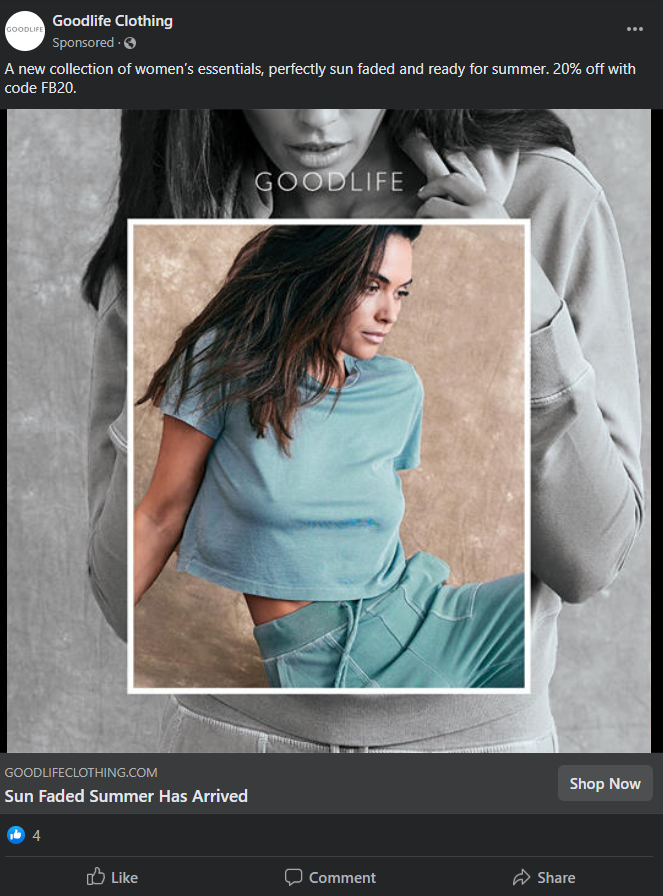
KPIs
When measuring desire, we utilize specific KPIs from the following platforms:
In-Engine KPIs include:
- Click-through-rate (CTR)
- Cost-per-click (CPC)
- Revenue
Google Analytics KPIs include:
- Transaction Revenue
- Assisted Conversion Revenue
- Overall ROAS
Measuring Success
The main goal of this stage of the customer journey is to drive home that revenue, but there is one caveat. The revenue reported from Facebook and Google Analytics can differ due to the view-through attribution used on each platform.
- By default, Facebook shows based on 1-day view and 28-day click, while Google Analytics defaults to a last-click attribution model.
How do you remedy this? By reporting on both platform’s revenue numbers, we’re able to see a more holistic view of how our paid social strategies are impacting the site, and the client’s bottom line as a whole.
Measuring Action
Goal
We’re moving toward the bottom of the customer journey and your client is interested in driving additional revenue to their site. We’ll use a similar approach discussed in the previous section, which includes retargeting consumers who have completed product-specific actions on site like viewing a product or adding something to the cart.
With the goal in mind of driving action, we recommend leveraging shopping campaigns for this stage in the funnel in order to retarget to consumers who have already viewed products on the site. To learn more about how Seer structures shopping campaigns, check this article out!
KPIs
When measuring action, we utilize specific KPIs from the following platforms:
In-Engine KPIs include:
- Revenue
- ROAS
Google Analytics KPIs include:
- Transaction Revenue
- Assisted Conversion Revenue
- Overall ROAS
Measuring Success
Once again, the main goal of this stage of the customer journey is to drive home that revenue. As a friendly reminder, the difference in view-through attribution on both platforms can cause a discrepancy in the revenue reported. The beauty of this is that a holistic view of your paid social strategies comes with utilizing both platform’s revenue numbers.
Measuring Evangelization
Goal
We’ve made it to the last stage of the funnel! Evangelization is a beautiful word in the sense that you’ve now acquired a customer base who can’t get enough of your client’s brand. Your next move is to keep that revenue comin’!
The goal of evangelization is to re-engage by utilizing tactics that up-sell and cross-sell your customer base. How do you up-sell? You advertise similar products to your customers by utilizing dynamic product carousel ads:
- Dynamic product carousel ads feature multiple products at once
- Save time by promoting your products using your catalog creative
Joah Brown slays their dynamic product carousel ads:
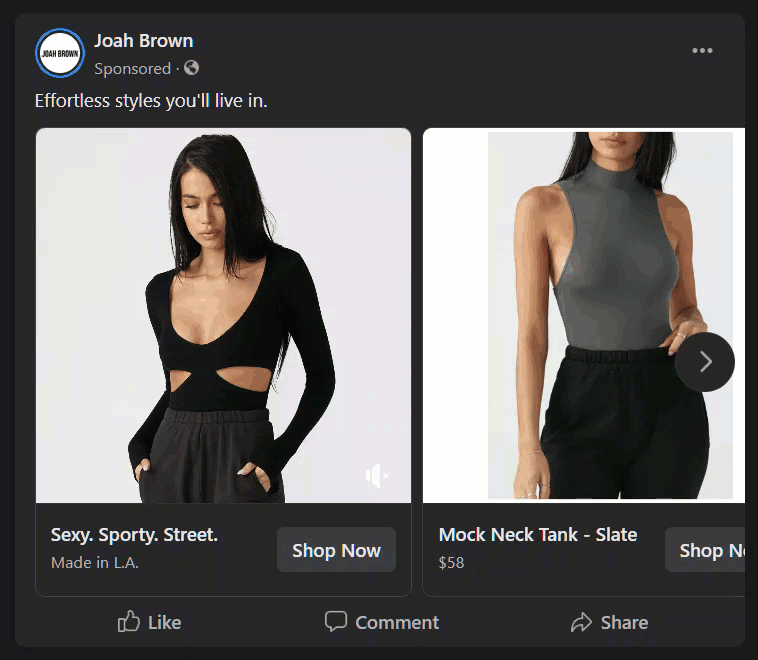
KPIs
When measuring evangelization, we utilize specific KPIs from the following platforms:
In-Engine KPIs include:
- Revenue
- ROAS
Google Analytics KPIs include:
- Transaction Revenue
- Assisted Conversion Revenue
- Overall ROAS
Measuring Success
The ultimate goal of this last stage of the customer journey is to increase the customer lifetime value. By introducing the consumer to additional products similar to ones they’ve previously engaged with, you’re utilizing the power of up-sell and cross-sell. Sit back and reap the benefits!
Reminder: Similar to the last two stages preceding, report on both platform’s revenue numbers to tell the most impactful story!
Data-Driven E-Commerce Opportunities
Rooted in data, we are able to take our measurement strategy a step further. By utilizing our internal tools, we’re able to gain additional insight into spend and budget trends that will lead to more impactful budget decisions:
- Are your budget’s set correctly for your weekly spend amounts?
- Which ad sets are overspending or underspending?
- And much more…
And there you have it folks, Seer’s paid social e-commerce measurement strategy. Using blended KPIs broken out by campaign goals, we’re able to make in-depth analyses and optimizations based on the unique KPIs we have created for your account funnel.
If you’re interested in working with us, make sure to drop us a line, and don’t forget to sign up for the Seer newsletter for the latest content!

